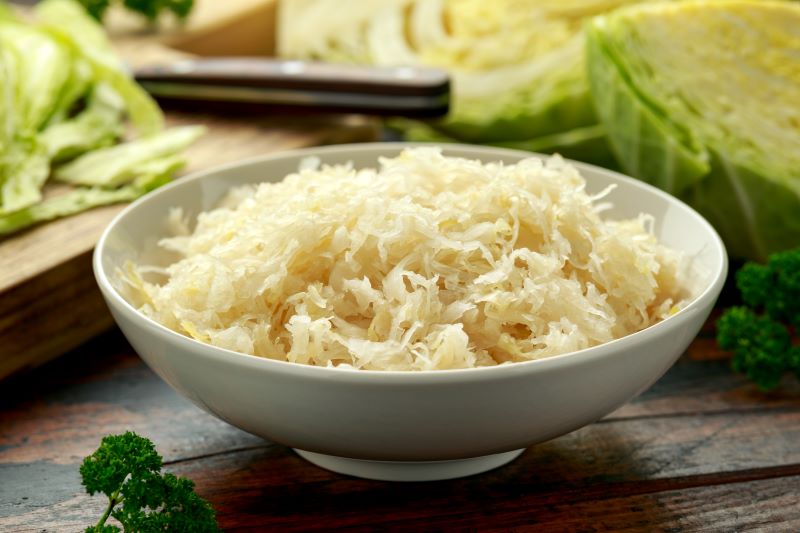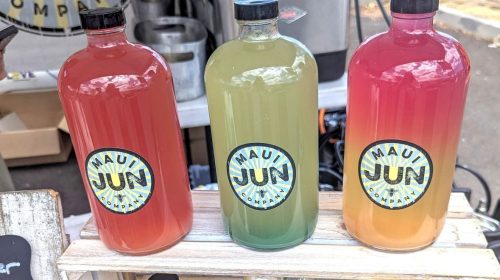Fermented Cabbage
By Tom Andersen
Cabbage is arguably one of the most humble of all the vegetables but with a rich history and some awesome fun facts. Here are a few of them: They have been cultivated for over 4000 years; 1000 years ago they cured baldness (wish I knew what happened to that strain); children, of course, come from a cabbage patch; cabbage was pickled in rice wine vinegar for the crews working the Great Wall project; Dutch sailors pickled them for long voyages preventing scurvy; Ghengis Khan brought pickled cabbage to Europe where the Germanic people named it “Sauerkraut;” during the two world wars, we temporarily re-named sauerkraut “Liberty Cabbage” – you know, like “Freedom Fries.” There’s more, but that’s enough for now.
Sauerkraut is really easy to make; but for this type of fermentation I’m going to ask you to buy something if you don’t already have one, and that’s a cheap digital kitchen scale. Our forebears may not have used one, but it will lend a measure of safety.
Sauerkraut, amongst other vegetables, makes its own brine. Cabbage has enough moisture in it to produce just the right amount of brine when combined with just the right amount of salt. The right amount of salt is key for two reasons. First, salt prevents undesirable bacteria from contaminating the fermentation. Too little and undesirables take over. Too much and the fermentation is slow or simply won’t start. Secondly, if there is too little or too much salt, nobody will eat it with you. Salt is safety and flavor.
I shoot for just over two percent salt by weight. That’s what the scale is all about. A two pound head of cabbage makes about a quart of sauerkraut. You will need a wide mouth jar and lid, a wide mouth funnel, two giant mixing bowls, pickle weights or a zipper plastic bag and a sharp knife.
Wash and drain your cabbage. Peel off the outer leaves and feed them to your chickens. Cut the head into quarters and remove the core. Shred the quarters into ¼ inch ribbons. Weigh the giant mixing bowl in ounces. Add the cabbage and subtract the weight of the bowl. Or, push the Tare button when you weigh the bowl. Next, multiply the weight of the cabbage by .02 and that’s how much salt you need. Two pounds of cabbage (32oz) will need about 2/3 oz of salt. I use pickling salt or salt that I collected from the sea. It just can’t have iodine or anti-caking agents in it.
Put a handful of cabbage into the other giant mixing bowl and add a little salt. Stir it up. Do this again and again until you are done. Let it sit for a half hour. It should have developed some liquid. Now, using your clean hands, squeeze, knead, roll, twist, mash and wring the cabbage for five minutes until it has developed quite a bit of liquid.
Stuff the cabbage into the quart jar — push hard — until it reaches the shoulder of the jar. The liquid should be above the cabbage. If you absolutely have to, add a little brine (one tsp salt to one cup water). Use your weight or put the plastic bag in (filled with water and zipped up). Put the lid very loosely on and place the whole thing on a pie pan as spillovers are a mess.
Wait three weeks but check it. If a little white mold grows on top, scoop it off and replace the weight. Anything more and oh well, it was just one cabbage. Taste it after three weeks or more. If it’s done, eat it and refrigerate what’s left. It should last a few weeks in there. I you made a ton of it, consider canning some using a good recipe from the National Center for Home Food Preservation nchfp.uga.edu.

Your pickled cabbage can be added to soups or served charcuterie style with sausages, smoked fish, mustard and a rustic artisan bread. Pair with a German-style Pilsner or Hefeweizen.
Featured photo: Pickled cabbage, aka sauerkraut, pairs nicely with a German-style beer such as Pilsner or Hefeweizen. Photo by Elevate
***
Have an local story or family recipe to share? The team at the San Lorenzo Valley Post welcomes your Santa Cruz Mountains news, story ideas, photos, and letters. Send us an email.
Sign up for our newsletter to stay connected to news and events in the Santa Cruz Mountains.





